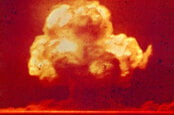This article is more than 1 year old
Nearly 70 years after America made einsteinium in its first full-scale thermo-nuke experiment, mystery element yields secrets of its chemistry
Atom bond length of Es measured for the first time
Chemists have measured a fundamental chemical property of einsteinium, a mysterious and radioactive element that was discovered in the debris of America's first full-scale thermonuclear device test – the Ivy Mike shot in 1952.
Einsteinium (Es) has an atomic number of 99 and is buried at the bottom of the periodic table, where it joins its fellow actinides. Scientists haven’t paid much attention to the element – named after super-physicist Albert Einstein – and it has remained more of a curiosity over the past 70 or so years.
The element is difficult to study; it’s not produced naturally on Earth, and is difficult to make in a lab. Now, a team of researchers at the Lawrence Berkeley National Laboratory, Los Alamos National Laboratory, and Georgetown University in the US have figured out the average distance between the nuclei of bonded atoms in an einsteinium sample, a vital insight into its characteristics.
“The bond length is 2.38 angstroms,” Korey Carter, first author of the study published in Nature, who is now an assistant chemistry professor at the University of Iowa, told The Register. “The bond distance is a foundational fact about an element. It tells us how something it binds to other atoms, and tells you something about its chemistry.”
It was measured by irradiating a tiny sample over 84 hours at Los Alamos. This X-ray absorption spectroscopy technique allowed the scientists to study the element’s atomic structure.
“The bond length was statistically significantly shorter than we expected, and that combined with the unexpected luminescence blue shift indicates that Es behaves differently than its predecessors in the actinide series,” Katherine Shield, co-author of the study and a PhD student at Lawrence Berkeley, told us.
What is it good for? Nobody knows yet
Now that the team has figured out its bond length, what next? Not a whole lot yet, it seems.
The scientists had less than 250 nanograms to play with. The folks at Lawrence Berkeley National Laboratory had to bombard a sample of curium with neutrons to form the einsteinium. The process is tricky because it normally creates californium, an element with an atomic number of 98, rather than einsteinium. “You cannot control the transmutation process,” Carter said.
Atoms of einsteinium are lost when one separates the elements to get a pure sample. At the end, you are left with a tiny amount to work with. And once the team forged that substance, they were immediately on a deadline. The isotope they produced, einsteinium-254, has a half-life of 275 days, and, in these circumstances, decays pretty much into berkelium-250. That has a three-hour half-life, and decays into californium-250.
It’s not immediately clear what einsteinium could be used for. The team would have to create more of the material to study it in detail. Carter believes it may have magnetic properties, which could lead to new types of materials. The element is also interesting for another reason: it could help chemists and physicists create elements yet to be discovered.
“Einsteinium is an ideal target for making super heavy elements with atomic numbers of 119 and beyond,” he said. The heaviest element in the periodic table so far is oganesson with an atomic number of 118. Scientists would have to bombard a large enough amount of einsteinium with neutrons to force the atom’s nucleus to grow.
“It was discovered by accident in the debris in the first hydrogen bomb,” Carter explained, referring to the 10.4MT Ivy Mike test. “The US military collected the debris, and sent the samples to labs around the US in 1952, where it was later discovered at Lawrence Berkeley National Lab. Chemists Glenn Seaborg and Albert Ghiorso, were pioneers in radioanalytical chemistry, realized there was something new there and designed experiments to confirm [einsteinium].”
At first it was classified information, and the results weren’t published until 1955. “There was some work done with einsteinium in the 1960s and 1970s at Argonne National Laboratory and Oak Ridge National Laboratory, but it hasn’t really been studied since the 1970s," Carter said. "Back then, scientists only had einsteinium-253 to work with.”
Einsteinium-253 has one less neutron in its atom compared to einsteinium-254, and is even more radioactive. It has a half life of just 20 days.
“Working and doing macroscopic studies with a substance with just a 20-day half-life is really difficult," Carter said. "Thankfully, we had worked with einsteinium-254 that has a longer half-life by a factor of 10. That really changes what is possible, and means certain facilities can study it.” ®

